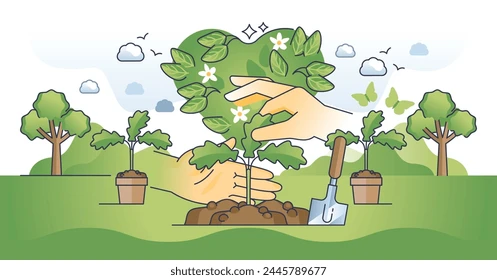How to planting trees effect on Environment, Planting trees provides many environmental benefits. They absorb carbon dioxide, reduce climate change, and release oxygen. Trees improve air quality by filtering pollutants and providing housing for various wildlife, thus increasing biodiversity. They also help prevent soil erosion, conserve water and regulate local temperature. However, the effect may vary depending on factors such as tree species and planting space. For example, some species may require more water or compete with existing ecosystems, requiring careful planning to maximize positive environmental effects.
How to planting trees effect on Environment, Planting trees has many positive effects on the atmosphere. Here is how plants help:
- Refinement
- Grip carbon dioxide CO2: CO2 is attached during trees photosynthesis, the decrease in the volume of this greenhouse gas in the part, which is a major donor for environmental change.
- Discharge oxygen: Trees discharge oxygen as a by -product of photosynthesis, which is important for all life on Earth.
- Street Air Pollutants: Trees can trap dust, ash, pollen and smoke, refine the air quality and prevent respiratory issues.
- Opposition to climate change
- Carbon sequence: Performing trees as a carbon sink, absorb and storage of carbon in their biomass, roots and soil. It reduces the caution of overall carbon in the atmosphere, reduces global warming.
- Soil maintenance
- Prevent erosion: The origin of the tree helps to tie the soil, prevents erosion from air and water. This is particularly important in areas affected by landslides or floods.
- Improve soil quality: Soil is increased by rotting leaves and organic materials from trees, its fertility is attractive.
- Water regulation
- Reduce the runoff: Tree coverings and roots helped catch rain water, allowing the surface to release and leak water into the ground. This aid prevents floods and increases groundwater recharge.
- Improve water quality: Trees clean the filters and water as it changes through the soil, releases pollution in rivers and lakes.
- Biodiversity support
- Residence for wildlife: Trees, birds, insects, mammals and fungi provide home and food for a variety of species. The forests are some of the most biodiversity environment on Earth.
- Support pollinators: Trees propose liquid and shelter to pollinators such as bees and butterflies, which are dangerous for crop production and overall biodiversity.
- Climate regulation
- Cooling the atmosphere: The help of the tree cools the environment by providing shade to the environment and discharging moisture through a process called evaporation, which cools the air. It can reduce the “Urban Heat Island” effect in cities.
- Microclimate construction: Trees can affect local weaving by creating coolers, more moist area, especially in urban environment, more moist areas in urban environment.
- health benefit
- Mental health: Green places with trees have been exposed to reduce stress and improve psychological welfare.
- Physical health: Trees in urban areas provide space for entertainment and exercise, promoting physical health.
- Provision of resources
- Wood and fruits: trees appreciate resources such as wood, fruits and nuts, donate both economic and ecological stability.
- Renewable energy source: wood from trees can also serve as a renewable energy source when it is continuously obtained.
The effectiveness of carbon sequence depends on factors such as growth, wood density, lifetime, site status and management. Below are some commonly recognized species and groups that perform well in many areas. Note that local suitability is important – local climate, soil and ecological ideas should guide the choice of species.
Rapid growth and wide species
- Hybrid poplar (eg, popular SPP. Hens)
O professionals: very fast development; High initial season carbon uptake.
O Opposition: Usually at least; Shallow roots in some soil; Irrigation may be required in dry areas.
- Eucalyptus SPP. (In suitable climate)
o professionals: High annual sequence in suitable warm, moist environment.
O opposition: concerns of water use in water area; Some species become aggressive outside the native categories.
- Southern Live Oak (Quercus Virginiana) and other long -lived oaks (where climate allows)
O professionals: large, long -living trees with dense heartwood; Strong carbon storage for centuries.
O Opposition: Slow growth; The species are limited by climate.
- American Beach (Phagas Grandfolia) and other temperate hard wood
O professionals: durable wood; Good long -term carbon storage in temperate areas.
- Black Walnuts (Juglons Nigra) and other high-gradings hard wood
O professionals: high wood density → more carbon stored per quantity; Valuable wood.
Conifer species (often good for long -term storage)
- Pseudotsuga menziesii
O professionals: rapid growth in temperate climate; Adequate long -term storage.
- Looboli Pine (Penus Teda) and Slash Pine (Penus Illoti)
O professionals: high growth in suitable soil; Well -understood silvic practices.
O Claun: In some areas, susceptible to pests/disease; Management is important.
- Coast Redwood (Sempervience) and Giant Seven (Seaviyadandron Giga
-
- Pros: Exceptional long-term carbon storage due to massive size and longevity (where climate supports).


